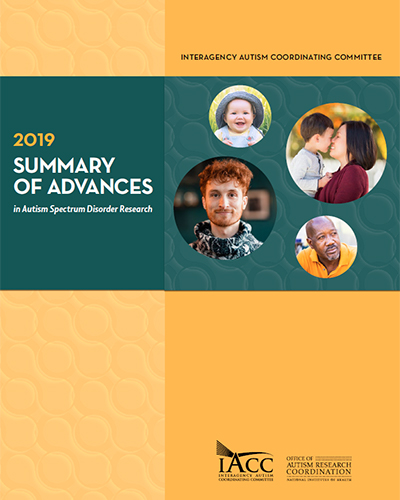Summary of Advances
In Autism Spectrum Disorder Research
2019
Predictors of Longer-Term Development of Expressive Language in Two Independent Longitudinal Cohorts of Language-Delayed Preschoolers with Autism Spectrum Disorder
Bal VH, Fok M, Lord C, Smith IM, Mirenda P, Szatmari P, Vaillancourt T, Volden J, Waddell C, Zwaigenbaum L, Bennett T, Duku E, Elsabbagh M, Georgiades S, Ungar WJ, Zaidman-Zait A. J Child Psychol Psychiatry.. 2019 Aug 19. [PMID: 31429087]
It is estimated that half to three-quarters of preschool children with ASD are minimally verbal. Although this percentage decreases with older age, language delays can persist even with intervention: studies show that one-third of young adults with ASD remain minimally verbal. Early indicators such as expressive communication, nonverbal cognition, joint attention, and motor skills can predict the trajectory of language development in young children, but little is known about the skills and behavioral markers that predict longer-term language abilities in individuals with ASD as they grow into adulthood.
In this study, researchers sought to identify the early predictors of expressive language outcomes in minimally verbal individuals with ASD from early childhood to early adulthood. The researchers used data from two independent samples of children with ASD who, at age 3, used single words or less during the administration of the PreLinguistic Autism Diagnosis Observation Schedule (ADOS). First, they assessed 86 language-delayed children with ASD from the Early Diagnosis (EDX) study as a “discovery” sample to identify the predictors of language outcomes. Then, they sought to replicate these findings using a cohort of 181 language-delayed children from the Pathways in ASD (Pathways) study.
The researchers administered the Mullens Scales of Early Learning (MSEL)—an assessment tool for language and motor skills—to children from the EDX study at age 3 and again at age 19 years. To identify the best long-term predictors of language outcomes, they implemented an exploratory statistical model called the Classification and Regression Tree (CART). They found that preschool fine motor skills were the strongest predictor of language abilities in early adulthood. Of the 40 young children who had extreme fine motor delays, 31 remained minimally verbal at 19 years of age. Additionally, an interaction between mild fine motor delay and joint attention emerged. Of the remaining 46 children who had mild fine motor delays, 13 children who also showed strong joint attention in preschool went on to develop phrase or fluent speech (as opposed to continuing to use single words or less).
Although age of walking was not a predictor of later language skills in the EDX study sample, the researchers found that 53% of the children who walked before 13 months remained minimally verbal at age 19, while only 29% of those who walked after 13 months remained minimally verbal. This result was somewhat unexpected and suggests that minimal expressive language in autistic children is not always associated with global delays.
The researchers sought to replicate these findings in the Pathways study sample to determine if the CART model could predict language trajectories in a larger group of children and with a different assessment tool (the Merrill Palmer-Revised Scales of Development, M-P-R). Like the MSEL, the M-P-R measures language, motor, and cognitive skills. In this sample, they conducted a follow-up assessment in children at an average age of 10.5 years and again found that fine motor skills predicted later expressive language abilities; children with milder fine motor delays showed better language gains at age 10.5 than children with more impaired fine motor skills. In this study sample, however, the interaction of fine motor skills and joint attention did not predict long-term language outcomes.
Overall, this study found that fine motor skills at age 3 significantly predicted later expressive language outcomes in children with ASD and delayed language. This was found to be consistent across two independent cohorts using different measures of fine motor skills. These findings suggest the possibility of a developmental cascade, wherein early fine motor skills encourage interactions with the environment that facilitate language development. This study also demonstrated the value of using more specific, well-defined skill areas rather than broad skill markers, which would help identify levels of developmental delay and better inform targeted interventions.




